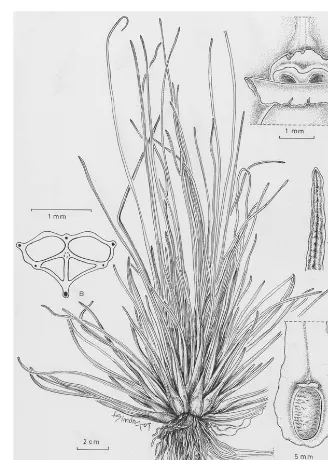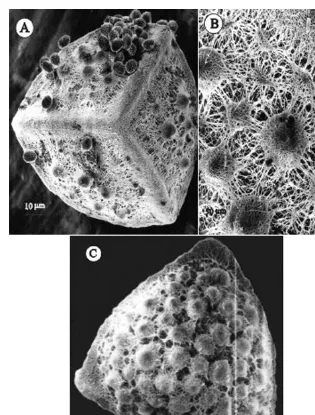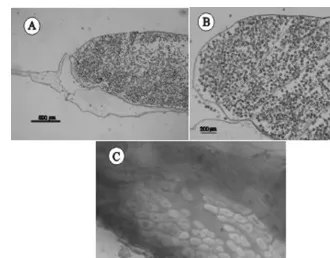(Annals of the Brazilian Academy of Sciences) ISSN 0001-3765
www.scielo.br/aabc
Isoetes pedersenii
, a new species from Southern South America
CECILIA MACLUF1, ESTEBAN I. MEZA TORRES2 and STELLA M. SOLÍS2
1Cátedras de Morfología Vegetal y Palinología, Facultad de Ciencias Naturales y Museo UNLP, Paseo del Bosque s/n, 1900, La Plata, Argentina
2Cátedra de Morfología Vegetal, Facultad de Ciencias Exactas y Naturales y Agrimensura Instituto de Botánica del Nordeste (UNNE-CONICET), Av. Libertad 5470, Corrientes, Argentina
Manuscript received on November 26, 2008; accepted for publication on September 28, 2009
ABSTRACT
The name Isoetes pederseniiH.P. Fuchs (Lycophyta), a species known only from the Mburucuyá National Park, Corrientes, Argentina, is validated. Observations were carried out on herbarium material with stereoscopic, light and scanning electron microscopes. The species is described and typified. A diagnosis and discussion about its distribution and its relationship with the morphology of other species ofIsoetesare provided.
Key words:Argentina, Corrientes,Isoetes, Lycophyta, new species.
INTRODUCTION
The Isoetaceae constitutes a family with a wide distribu-tion. The representatives of this family live from sub-artic to warm regions in all continents from sea level to approximately 4,500 high. Isoetes L. has about 350 species (Hickey et al. 2003), of which seven species were reported by Ponce (1996) as growing in Argentina. They occur in the provinces of Buenos Aires, Formosa, Córdoba, Tucumán, and in the Patagonian region. Later, Macluf and Ponce (2008) updated the occurrence of Isoetesin Argentina.
The two farms that constitute the Mburucuyá Na-tional Park belonged to the botanist Dr. Honoris Causa Troels Myndel Pedersen, who donated these farms in or-der to create a national park. For 50 years Peor-dersen was an assiduous collector who formed a herbarium with ap-proximately 30,000 specimens (Arbo 2004). The dupli-cates of his collections were distributed to the following herbaria: A, B, BR, C, CTES, K, L, LP, MBM, MO, NY, P, S, SI, U, US, and his collections are cited like this in many taxonomic revisions (Krapovickas 2000). These
Correspondence to: Cecilia Macluf
E-mail: ccmacluf@aol.com; ccmacluf@hotmail.com
collections gave to this park an added botanical value, since many of Pedersen´s specimens were recognized as types for many new species (Arbo 2004).
During the development of the Project “Flórula del Parque Nacional Mburucuyá”, subproject “Flórula Pteri-dophytica”, several nomenclatural problems became ev-ident for the treatment of taxa in that national park. One of the nomenclatural problems concernsIsoetes peder-senii, which was effectively published for the first time by H.P. Fuchs-Eckert (1982) and later accepted by Mac-luf et al. (2006a, b). However, in none of the publica-tions it was published with a latin diagnosis as specified in articles 32.1 of the International Code of Botanical Nomenclature of Vienna (Mc Neill et al. 2007). Fuchs-Eckert (1982) mentioned the existence of a holotype housed in the Herbarium of Paris (P), which was col-lected in Corrientes, Argentina. The data supplied in the publication is mentioned below:
“Isoetes pedersenii (H.P. Fuchs, in sched. Rev., in hbP(24 December 1980) ined.) Ar-gentina (Prov. Corrientes) Holotypus:P
354 CECILIA MACLUF, ESTEBAN I. MEZA TORRES and STELLA M. SOLÍS
ex) METTENIUS 1859, Fil. Lechl. (2): 36, in textu (Januar 1859),nomen seminudum,ex) A. Braun 1862, in Verhn. Bot. Ver. Prov. Bran-denbeg.”
R.J. Hickey (1985), in his unpublished thesis, up-dated the neotropical species of Isoetes, and provided an English description of Isoetes pedersenii. Later, Macluf et al. (2006a, b) performed an analysis with electron microscopy of the microspores of all the species of Southern South America, among whichI. pedersenii was included. Additional background information on this name was documented in correspondence dated XI.30.1981 sent by Fuchs to Pedersen, which is kept in the Library of the Botany Institute of the Northeast (IBONE). A list of specimens collected by Pedersen and determined by Fuchs was provided in this letter. In the detail of a specimen, the following is specified:
“T.M. Pedersen, no. 8105: Isoetes pedersenii H.P. FUCHS, in sched., ined. (TYPUS).”
As part of the study of the Isoetoids that grow in Southern South America and within the boundaries of the Project “Florula of the National Park Mburucuyá”, the name used by Fuchs-Eckert (1982), R.J. Hickey, un-published data and Macluf et al. (2006a, b),Isoetes pe-dersenii, is described, typified and validated in accor-dance with the standards imposed by the International Code of Botanical Nomenclature.
MATERIALS AND METHODS
Studies were performed on herbarium material bor-rowed from several herbaria, which are abbreviated in accordance with Holmgren et al. (1990). The mate-rial was recovered by warming it in distillated water with some drops of non-ionized detergent. Permanent preparations were made for the anatomical descriptions. This material was dehydrated in an ascending series of tertiary butylic alcohol and was introduced into paraf-fin (Johansen 1940); transverse sections were made with a rotary microtome at 12-15µm. These were dyed with saffranine-astra blue (Luque et al. 1996) and were mounted in Canada balsam.
Observations and photographs were taken with a Leica DM LB2 light microscope (LM), with a digital
camera included an Olympus CO11 stereoscopic micro-scope dissectins micro-scope. Illustrations of features were carried out with a Wild M5 stereoscopic microscope and an Olympus BX 50F binocular microscope. For studies with SEM, the spores were handled with moist brushes without any chemical treatment and placed on double-stick tape on bronze stubs. The samples were coated with gold and examined under a Jeol JSM-35 CF micro-scope at the SEM laboratory of the Facultad de Ciencias Naturales y Museo, Universidad Nacional de La Plata, La Plata, Argentina.
Megaspore morphology follows the terminology proposed in Tryon and Lugardon (1991).
RESULTS
Isoetes pederseniiH.P. Fuchsex Meza T. and Macluf, spec. nov. (Figs. 1–4).
Cormus erectus, bi e trilobatus, 18 mm latus, 11 mm elatus; radices dichotomae. Folia 70-80, erecta, 12-30 cm longa, 4-6 mm basi lata, 1-6 mm lata; alae hyaline et membranaceae, 3 mm basi latae, 2 mm medio latae, 10-25 cm longae (50% per folia longitudinem ascen-dentes); fasciculi fibrosi praesentia; subula triquetrus, atroviridis; stomata praesentia; squamae phyllopodia absentia. Sporangium ellipticum usque circulare, hyal-inum, 5-6 mm longum, 3 mm latum, basale. Velum incom-pletum, revolutus versus is apex. Ligula deltata, auricu-lata, 1.3 mm longa, 1.85 mm lata. Labium inconspicuum usque absens. Megaspores, 395-411µm diametro, ver-rucosae, verrucae 21.3-43.4µm diametro; zona non dis-similis. Microspores, 30-35µm longae, 20-24µm latae, echinatae.
Holotypus:Argentina, Corrientes province: Dep. Mbu-rucuyá, Estancia Santa María, low generally flooded land, 18 March 1967,Pedersen 8105 (CTES);Isotypi: A, C, LP, P, S.
Etymology:The species was dedicated by Fuchs to Dr. T.M. Pedersen, collector and expert of the flora from Corrientes who collected the type specimen.
Fig. 1 –Isoetes pedersenii. A – Plant habit. B – Cross section of the subula (terminal region of a microphyll), with 4 air chambers, fiber bundles (black circles) and vascular tissue (cut line). C – Detail of the labium folded in order to let the ligule remnant be seen. D – Basal portion of a microphyll with megasporangium. E – Cross section of microsporangium, with trabeculae arranged transversely. F – Detail of the subula apex. (Pedersen 8105, CTES).
to 25 cm long (extending until 85% of the leaf length); fibrous bundles present; subula triquete, dark green (Fig. 1, F); stomata present;scalesand phyllopodia ab-sent. Sporangium elliptic to oval, hyaline, 5-8 mm long, 3-5 mm wide, basal (Fig. 4, A-B). Velum absent. Ligule deltoid, auriculate at base, 1.3 mm high, 1.85-2 mm
356 CECILIA MACLUF, ESTEBAN I. MEZA TORRES and STELLA M. SOLÍS
Fig. 2 –Isoetes pedersenii. A-C. Megaspores observed with SEM. A – Proximal view. The laesurae join in the equatorial zone or cingulum. Microspores are observed on the megaspore surface. B – Detail of the proximal structure showing tubercles of different diameter. C – Distal View. (Pedersen 8105, LP).
Isoetes pedersenii perhaps is endemic of Argen-tina, and is known only from the type collection made in Mburucuyá National Park, Corrientes. It grows in flooded land; the presence of stomates and fibrous bun-dles and the absence of scale leaves suggest an amphi-bious habit. Isoetes pedersenii is probably to be also found in the adjacent regions of Argentina, Paraguay and Brazil.
Isoetes pederseniiis distinguished from other spe-cies by its megaspores and microspores, and to the type
of subula (microphyl tip). Morphologically, it is similar toIsoetes panamensisMaxon and C.V. Morton and to Isoetes gardnerianaA. Braun, from which it is differen-tiated mainly by the megaspore ornamentation. Isoetes panamensishas cones on the megaspore surface, whereas inI. gardnerianathe megaspores have tubercles.
OBSERVATIONS
lat-Fig. 3 –Isoetes pedersenii. A-D. Microspores observed with SEM. A – Proximal view (top) and equatorial view (bottom). B – Major equatorial view showing the echinate-tuberculate ornamentation. The echinae are higher and more densely distributed distally. C – Lower equatorial view showing the supra-laesural ex-pansion (Macluf et al. 2006a). D – Detail of the equatorial surface. The orna-mentation consists of cones distributed in the entire surface. Some cones show their apex broken. (Pedersen 8105, LP).
eral, and one abaxially, with strongly lignified thick walls and reduced lumen, immersed in a subepidermal (tissue) parenchyma (Fig. 1, B, Fig. 4, C). The pres-ence or abspres-ence of peripheral fibers, number and loca-tion of Isoetes have been considered to be a diagnos-tic feature by many authors (Pfeiffer 1922, Parker 1943, Takamiya et al. 1997, Prada and Rolleri 2003), but not by other authors such as Hall (1971) and Kott and
[image:5.709.171.461.83.482.2]358 CECILIA MACLUF, ESTEBAN I. MEZA TORRES and STELLA M. SOLÍS
Fig. 4 –Isoetes pedersenii. A-C. Cross sections observed with LM. A – Cross section of the microsporangium, with microspores inside. B – Detail of the microsporangium where trabeculae can be seen. C – Micrograph of the sclerenchymatic beads of the microphyll. (Pedersen 8105, CTES).
ACKNOWLEDGMENTS
The authors thank Eng. A. Krapovickas for his critical reading; Rafael Urrejola from the Scanning Electronic Microscopy Service of the “Museo de Ciencias Natu-rales de La Plata”; Laura Simón for the illustrations; and the reviewers for useful comments on the manuscript. This work was supported by the grant from the National Council of Scientific and Technological Research (CON-ICET) PIP 5044, and the National Agency of Scientific and Technological Promotion (ANPC y T) PICT 12.758.
RESUMO
O nomeIsoetes pedersenii H.P. Fuchs (Lycophyta) foi vali-dado para a espécie identificada apenas no Parque Nacional de Mburucuyá, em Corrientes na Argentina. Material preser-vado em herbário foi avaliado com microscópios estereoscó-pico, de luz branca e eletrônico de varredura. A espécie foi descrita e tipificada. Um diagnóstico e uma discussão sobre a distribuição e relação com a morfologia de outras espécies de Isoetessão relatados.
Palavras-chave: Argentina, Corrientes, Isoetes, Lycophyta, nova espécie.
REFERENCES
ARBOMM. 2004. Flórula del Parque Nacional Mburucuyá. In: ACEÑOLAZAFG (Ed), Temas de la biodiversidad del Litoral Fluvial Argentino. INSUGEO. Tucumán, Mis-celánea 12.
FUCHS-ECKERTHP. 1982. Zur heutigen Kenntnis von Vor-kommen und Verbreitung der südamerikanischen Isoëtes-Arten. Proceedings of the Koninklike Nederlandse Aka-demie van Wetenschappen, Series C 85: 205–260. HALL JB. 1971. Observations onIsoetesin Ghana. Bot J
Linn Soc 64: 117–139.
HICKEYRJ, MACLUFCCANDTAYLORWC. 2003. A Re-evalutation ofIsoetes savatieriFranchet in Argentina and Chile. Amer Fern J 93: 126–136.
HOLMGREN PK, HOLMGREN NH AND BARNETT LC. 1990. Index Herbariorum, 8th ed., NYBG, New York USA, 693 p.
JOHANSENDA. 1940. Plant microtechnique. McGraw-Hill Book Company, Inc., New York.
KRAPOVICKAS A. 2000. Troels Myndel Pedersen (26.IX. 1916–5.II.2000). Bonplandia 10: 193–196.
LUQUE R, SOUSA HC AND KRAUS JE. 1996. Métodos de coloração de Roeser (1972) – modificado – E. Kropp (1972), visando a substituição do azul de astra por azul de alcião 8GS ou 8GX. Acta Bot Bras 10: 199–212. MACLUFCANDPONCEM. 2008. Isoetaceae. In: ZULOA
-GA ET AL. (Eds), Catálogo de las plantas vasculares del Cono Sur (Argentina, Sur de Brasil, Chile, Paraguay y Uruguay) I: Pteridophyta, Gymnospermae y Monocoty-ledoneae. Monographs in Systematic Botany from the Missouri Botanical Garden 107: 984.
MACLUF C, MORBELLI MA AND GIUDICE GE. 2006a. Microspore Morphology ofIsoetes (Lycophyta) species from Southern South America. Bot Rev 72: 121–134. MACLUF C, MORBELLI MA AND GIUDICE GE. 2006b.
Microspore Morphology ofIsoetes species (Lycophyta) from Southern South America. Part II. TEM analysis of some selected types. Bot Rev (Lancaster) 72: 135–152. MC NEILLJET AL. 2007. International Code of Botanical
Nomenclature (Vienna Code) adopted by the Seventeenth International Botanical Congress Vienna, Austria, July 2005. In: GANTNERVERLAG ANDRUGGELLLICHT -ENSTEIN(Eds), Regnum Vegetabile, 146, XVIII, 568 p.
PARKER D. 1943. Comparison of aquatic and terrestrial plants ofIsoetes engelmanniin the Mountain Lake, Vir-ginia area. Am Midl Nat 30: 452–455.
PFEIFFERNA. 1922. Monograph of the Isoetaceae. Ann Mo Bot Gard 9: 79–232.
PONCEMM. 1996. Pteridophyta. In: ZULOAGAFOAND MORRONE O (Eds), Catálogo de las Plantas Vasculares de la República Argentina I: Pteridophyta, Gymnosper-mae y AngiosperGymnosper-mae (Monocotyledoneae). Monographs in Systematic Botany from the Missouri Botanical Gar-den 60: 1–79.
PRADAC. 1979. Estudio de la anatomía foliar de las especies españolas del géneroIsoetesL. Lagascalia 9: 107–113. PRADACANDROLLERIC. 2003. Caracteres diagnósticos
fo-liares en taxones ibéricos deIsoetesL. (Isoetaceae), Pteri-dophyta). Anales Jard Bot Madrid 60: 371–386. TAKAMIYAM, WATANABEMANDONOK. 1997.
Biosys-tematic studies on the genusIsoetes(Isoetaceae) in Japan. IV. Acta Phytotaxon et Geobotánica 48(2): 89–122. TRYONAFANDLUGARDONB. 1991. Spores of the



